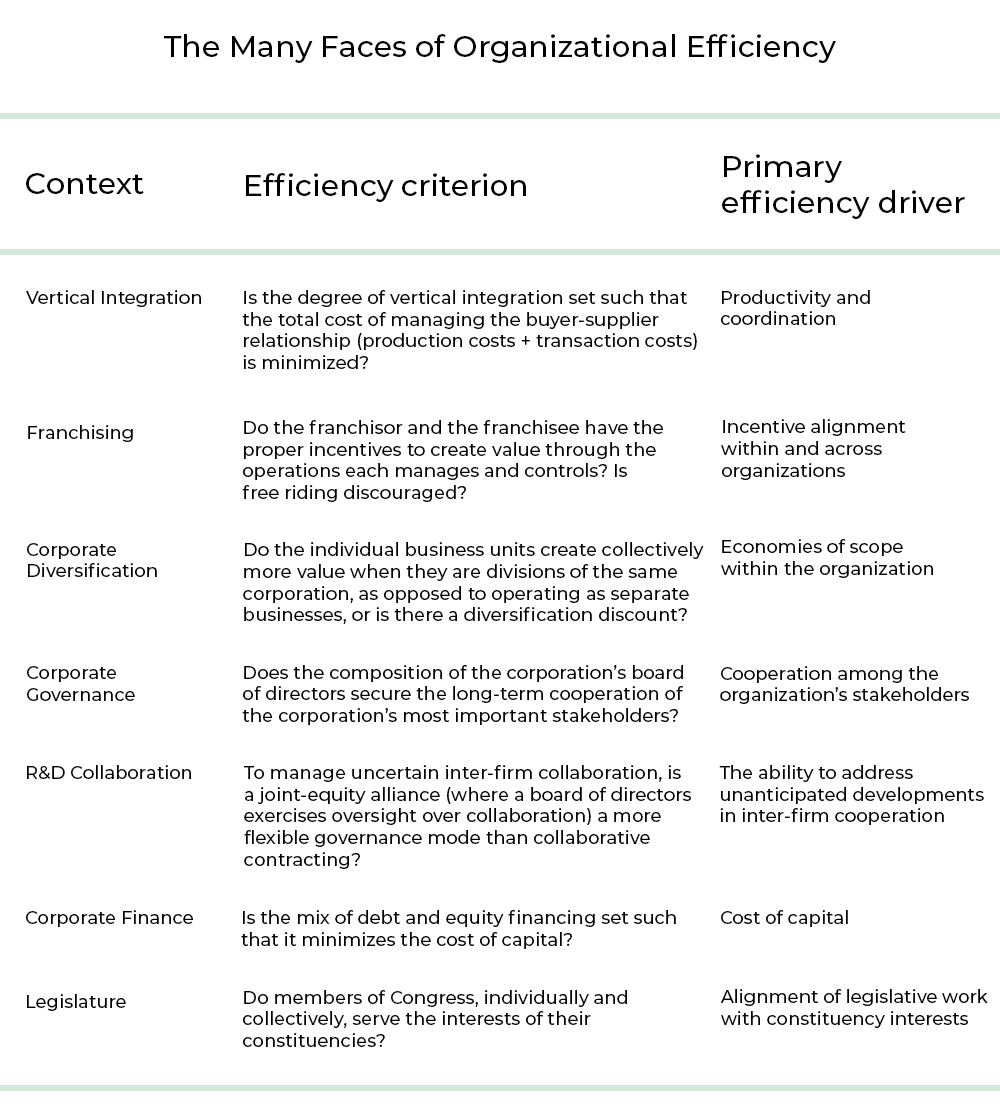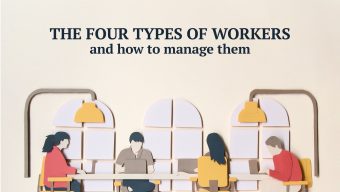If there are two alternative ways of doing something, why not choose the one that generates less waste?
Simple enough. Now try to apply it in a complex organization facing an uncertain future. Problems start at the fact that waste comes in many forms, some of which may be difficult to pinpoint. Delayed flights, expired Covid vaccines, and a high scrap rate in production are salient forms of waste, but how about the notion that communication, attention, and cognition can be wasted as well? Yes, sometimes the very act of having to think about something can be a form of waste.
Economist Frank Knight famously equated avoidance of waste with efficiency.
I am painfully aware of how dangerous that word is. When organizations seek efficiency, they downsize, they squeeze every penny out of their suppliers by aggressively renegotiating contracts, they make employees work more hours without additional pay, the list goes on. This is efficiency, right?
Allow me to me propose that these examples represent efficiency the same way undercooked poultry represents nutrition: hazardous. I prefer to label ruthless cost-cutting as myopic efficiency. This is not only distinct from but downright antithetic to sustainable efficiency, which is about eliminating the excess, not the essential; nurturing cooperation, not jeopardizing it; mutual value creation, not unmitigated self-interest.
I am trying to think of examples of bullying providing a long-term solution to an efficiency problem but cannot come up with one. Can you?
Efficiency comes in many guises. In my collaboration with organization economist and strategy scholar Joe Mahoney of the University of Illinois, we have cast a wide net to unearth and analyze different manifestations of efficiency in different organizational contexts (available in a forthcoming book published by Oxford University Press.) The following table provides seven different examples of organizational efficiency and its drivers.
Adapted with some modifications from Ketokivi and Mahoney. Reprinted with permission from Oxford University Press © 2017.
Allow me to elaborate on two examples, one familiar and the other perhaps a little surprising: vertical integration and the legislature.
About twenty years ago, I sat in an industry seminar with a number of purchasing managers, one of whom lamented the complexity of a problematic supplier relationship that kept him up at night. The contract with the parts supplier contained several hundred pages of legal and technical specifications that were beyond the ability of any one individual to comprehend in their entirety. I asked the manager whether the daily costs of enforcing the contract were considered jointly with the productivity benefits associated with outsourcing the parts instead of making them in-house, which is what the firm had done in the past.
The manager appeared puzzled at my question, but really he should not have been. Transaction costs are just as real and as relevant as production costs. The drafting and the daily enforcement of a complex contract constitute a real cost that should be directly attributed to the transaction instead of being considered overhead. Also, not being able to sleep at night… what a waste!
This anecdote introduces my first example: vertical integration. Which components should the final assembler produce in-house and which should be purchased from external suppliers? Should a firm have its own legal department to handle intellectual property issues or should it contract an external law firm? More generally, how should the organization approach the canonical “make-or-buy decision”?
It is unsurprising that many outsourcing decisions do not lead to the kinds of cost savings that were first envisioned.
How should the insomniac manager apply efficiency thinking in the make-or-buy decision of the component? The obvious part of the analysis is to compare the internal production costs to the price at which the external supplier would sell the part. This analysis should be comparatively straightforward. I have the creeping suspicion this was the criterion on which the outsourcing decision was originally made: The direct internal production cost was higher than the price the external vendor offered.
The more elusive part is the cost of contracting. If the parts are standardized and alternate suppliers are available, then purchasing the parts would amount to little more than “ordering them from a catalog.” For example, it should not come as a surprise that car manufacturers do not make tires. Tire sizes are standardized and specialized tire companies such as Bridgestone and Continental produce tires for all automakers. Due to massive economies of scale and economies of specialization, they are far more efficient in developing and producing tires than individual automakers could hope to be. Since contracting costs are negligible, the logic suggests it is more efficient to buy tires from specialized manufacturers instead of making them in-house.
The issue becomes more complicated for customer-specific parts that require make-and-model-specific engineering. Parts are no longer simply picked from a catalog but are, instead, designed, redesigned, and exchanged in collaborative long-term relationships. Car seats, and entire car interiors, are good examples. These relationships include all kinds of sunk costs and relation-specific investments, which are usually comparatively easier to manage if the buyer and the supplier are divisions of the same firm. Internal disputes are always alleviated by the fact that they are subject to corporate intervention. Yet, if the transacting parties are separate firms, such intervention is not possible. Further, in the case of internal transactions, there is also a strong incentive to address problems through internal organization, because litigation is not an option—courts do not hear or settle internal disputes.
A comparative analysis that incorporates transaction costs may, or may not, change the conclusion one would draw based on a comparison of production costs only. But we will not know until we do the math. At any rate, it is unsurprising that many outsourcing decisions do not lead to the kinds of cost savings that were first envisioned. Not incorporating transaction costs may have something to do with it.
Let me now turn to a more elusive example. In their insightful economic analysis of the legislature, Barry Weingast and William Marshall noted that the United States Congress was organized in a seemingly efficient way.
What does efficiency mean in the context of the legislature? It is useful to start by observing that lawmakers indeed have considerable incentives to exchange support with one another. Indeed, legislators often actively seek “trading partners” to further the interests of their own constituencies.
Note that the question is not whether the legislature makes smart decisions and passes high-quality laws, but rather, whether legislators, individually and collectively, succeed in introducing legislation that serves their constituencies. The question is not one of the quality of the decisions, but rather the alignment of legislative work with the interests of the electorate.
Exchange of votes runs into severe problems in daily legislative practice. The issues of interest of two “trading partners” do not come up for a vote simultaneously and, therefore, packaging bills into a single “market exchange” is infeasible: When trading is non-simultaneous, how can the legislator who delivers first trust that the other will deliver later? Opportunism aside, what if an unforeseen circumstance (e.g., failure to get re-elected) leads to a situation where the other party is simply unable to fulfill its side of the bargain? The simple market form of exchange becomes inefficient due to problems with enforceability.
A better alternative? The ubiquitous committee system found in legislatures around the world. The committee system provides protection against the uncertainties associated with market exchange. In many ways, the legislature functions more like a firm than a market. In the same way that the R&D department of an industrial firm focuses on product and service development tasks and the sales and marketing departments on revenue creation, the U.S. House Committee on Energy & Commerce controls the agendas within its jurisdiction as it decides which bills to bring to the House floor for a vote.
The non-obvious function of the committee system is to introduce stability that enables comparatively more efficient legislative bargaining. While by no means perfect (no governance alternative is), it can be argued to be more efficient than simple market exchange, because the non-simultaneity problem is addressed.
I bet you never thought of the legislature in this way. Yet, from an efficient-bargaining point of view, perhaps automobile supply chains and legislatures are not all that different.
What ultimately drives efficiency in organizations? As the table above suggests, it depends. There are likely multiple drivers in all situations, but one driver may dominate. For example, in the vertical integration case, efficiency is a function of productivity (e.g. economies of scale and economies of specialization) and coordination costs. In contexts such as franchising, the main driver may be the alignment of incentives, and in the case of corporate finance, the cost of capital. Just like efficiency comes in many guises, so do its drivers – the common denominator of all is that they work toward eliminating waste in all its forms.
Obviously, some coordination and negotiation is always necessary. The problem is that if you find yourself spending disproportionate amounts of time on coordination (at the expense of getting the work done) or if you find that no amount of negotiation aligns stakeholder interests in a way that secures cooperation, you have an inefficient organization.
This is all about matters of degree. Identifying the excessive and the disproportionate is central. To this end, organization economist and Nobel Laureate Oliver Williamson consistently encouraged organization designers to consider issues in their entirety. This analysis calls for incorporating all aspects of efficiency—not just the familiar, readily measurable parts—into the decision. This fosters sustainable efficiency, which should stand at the foundation of all organizations seeking long-term viability. Efficiency remains elusive and challenging, but smart minds always find ways to improve.
© IE Insights.









